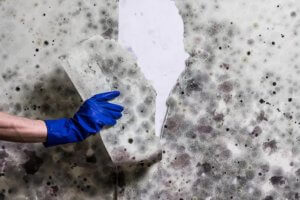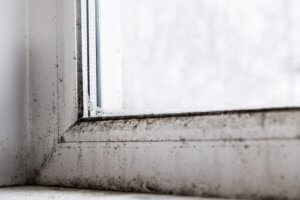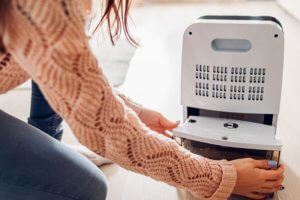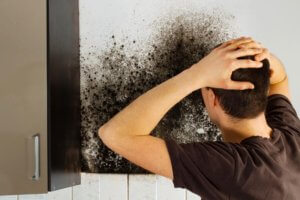BLOG

Indoor Mould Removal Guide
Mould can often be found in most properties, especially in places that are damp and poorly ventilated. Left untreated, mould can continue to multiply and spread creating a toxic environment that can affect the health of humans and pets that regularly come into contact with it.
If you happen to find mould within your home or property, it’s best to prevent further spread and prioritise mould removal and clean up. Read on to find out more about mould and what effective mould removal entails in order to prevent its return and continued spread.
What Is Mould?
Mould is a form of fungus that spreads by producing spores that float through the air.
Spores not visible to the naked eye can find their way into homes and indoor spaces by floating through the air and entering through open windows and doorways. Mould spores can also make their way indoors by attaching to people’s shoes, pets, clothing and cars.
Once a spore comes into contact with a damp spot indoors, mould will then begin to grow. A telltale sign of mould growth is the appearance of a dark green or black fuzzy growth with a musty odour.
Where Does Mould Grow?

Given the right warm and moist conditions, mould can easily thrive on various surfaces including wood, glass, plastic, fabric and paper.
In particular, mould tends to appear in areas where:
- Water leaks and flooding has occurred
- Where window condensation occurs
- Air is stagnant and doesn’t circulate (e.g. behind cupboards and storage areas)
Common places to check your home for mould include:
- Shower and bathtub
- Sinks and toilet
- Ceiling, walls and floor
- Upholstery
- Carpeted areas
- Insulation materials
- Fridge area
- Windows
- Airconditioning/heating vents
- Couch
- Curtains
- Ceiling fixtures such as fans
- Fireplace
- Attic, basement or garage
How Does Mould Affect Health?

While seemingly harmless, mould can pose major health problems especially for those with allergies, respiratory problems or those with weakened immune systems.
Mould produces allergens and irritants that can be toxic – particularly for those who have a sensitivity to them. Mould particles can irritate the lungs, nose and throat of people who have pre-existing breathing problems, asthma or chronic lung conditions.
Mould can also cause symptoms such as a blocked or runny nose, sneezing, watery eyes and even trigger an asthma attack in sufferers.
How To Prevent Mould Growth

Keeping moisture and humidity under control as well as providing adequate ventilation is the best way to prevent mould growth.
Some ways to reduce indoor moisture build-up include:
- Quickly mopping up spills and leaks
- Opening windows up to allow air circulation
- Using a dehumidifier
- Avoid drying clothes indoors
- Regularly cleaning surfaces so that mould can’t build-up
- Using mould cleaning products in bathrooms and toilets
- Ensuring fabrics are fully dry before storing them away
- Calling a plumber in the event of a roofing or plumbing leak that needs to be repaired
How To Clean And Remove Mould

It’s possible to remove small to medium-sized areas of mould yourself by following these steps below:
- Eliminate the source of moisture – identify and remove the source of moisture and humidity from the affected area.
- Dispose of any mouldy items that cannot be cleaned e.g. cardboard, paper and mattresses.
- Wash mildly affected fabrics in a hot wash cycle and throw out any items that cannot fit into a washing machine.
- Clean hard surfaces thoroughly using any of the following:
- Bleach – ideal for non-porous surfaces. Dilute 1 part bleach to 10 parts water and apply to the surface with a sponge.
- Baking soda – prepare a solution of 1 tablespoon of baking soda to 4 glasses of water and spray the mouldy area.
- Vinegar – mix 1 part of vinegar with 1 part of water and spray onto a mouldy area. Leave to sit for an hour before wiping off with a damp cloth.
- A commercially produced mould removal product
Be sure to use personal protective equipment such as masks and thick gloves when cleaning with the above chemicals.
When To Call A Professional

Not sure if you should call a professional mould removal specialist or DIY? It’s probably best to call a mould removal specialist if you find yourself in the following scenarios:
- When the indoor space affected by mould is several metres in size
- When your property has sustained a water leak or water damage
- You can smell the presence of mould
- The mould is visible to the naked eye
Call NTCSC For Fast, Effective Indoor Mould Removal
Stop the spread of mould in your home or indoor space today. Call the professional mould cleaners at National Trauma (NTCSC).
With over 30 years in the mould removal and cleaning business, we know how to effectively remediate and remove mould to prevent further spread to other areas of your home or property.
Call us today on 0488 007 675 to ask about our mould removal services and request an obligation free quote.

